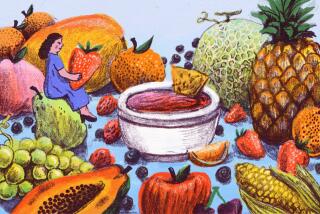The Juicy Fruits
- Share via
A rose is not just a rose, and neither is a grapefruit a grapefruit, a tangerine a tangerine, an orange an orange or a lemon a lemon.
For example, there are two “new” varieties of grapefruit now appearing with some regularity in local produce departments and growers markets--and that’s in addition to the well-known pink varieties.
* The pomelo, of course, is nothing new. Long grown in Indonesia, it is in fact the ancestor of our present-day grapefruit, which was developed after Dutch traders brought the pomelo to the Caribbean. The origin is reflected in the grapefruit’s various names: pamplemousse in French, Pampelmuse in German, pompelmo in Italian and pomelo in Spanish.
You’ll know a pomelo when you see it. It looks like an ordinary grapefruit on steroids, sometimes growing as big as a human head. Much of that volume is taken up by the white pith, of which it has an inordinate amount, making it perfect (in the opinion of the late British food writer Jane Grigson) for candying. The flesh of the pomelo is less juicy than the grapefruit’s but has much the same balance of sweet and tart.
* The oro blanco grapefruit, on the other hand, is appreciated mostly for its sweetness. Think of it as a white “pink” grapefruit, though the taste is a bit more complex. It too has a thicker-than-normal rind.
* There’s been a lot of talk about honey tangerines (actually a turn-of-the-century American variety called Murcott) for the past couple of years, particularly in Asian markets. This year they’re showing up in stores in a big way. Deep-orange in color, they are extremely juicy and very sweet. Don’t be put off by surface scarring. Most honey tangerines are grown in Florida, and the high humidity makes the skin soft and extremely susceptible to damage; the fruit inside is not affected.
* Blood oranges--long a symbol of the Mediterranean--now are being grown commercially in California. They have dark-red flesh and juice and an intriguingly sweet, berry-like flavor.
* The Meyer lemon, a favorite California back-yard fruit, is showing up with some regularity at growers markets and even occasionally in better produce departments. The Meyer has a smoother and more delicate skin than the familiar Eureka lemon, and the juice is sweeter and spicier, almost like a cross between lemon and tangerine.
More to Read
Eat your way across L.A.
Get our weekly Tasting Notes newsletter for reviews, news and more.
You may occasionally receive promotional content from the Los Angeles Times.











